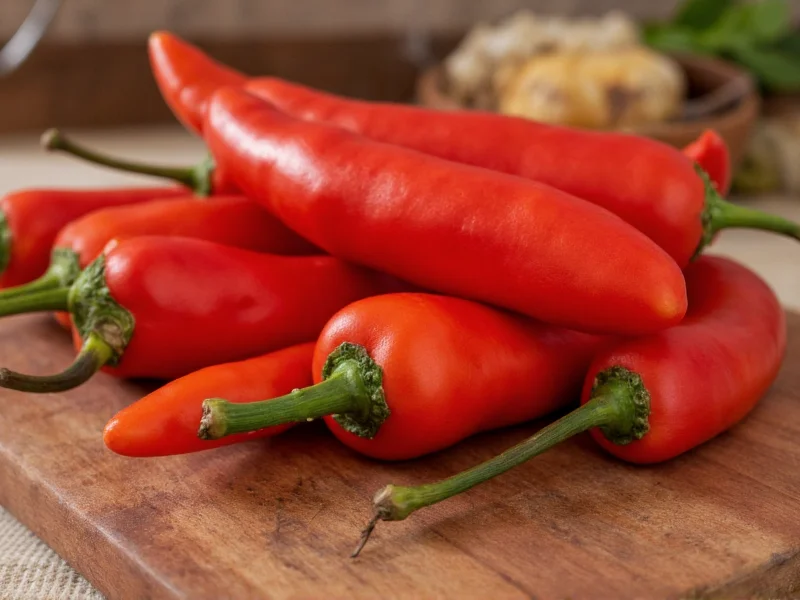Calabrian chilies, known locally as peperoncini<\/em>, are distinctive Italian peppers prized for their complex flavor profile that balances moderate heat with subtle fruitiness. Native to Calabria in southern Italy, these vibrant red peppers typically measure between 30,000-50,000 Scoville Heat Units (SHU), placing them in the medium-heat category—hotter than jalapeños but milder than habaneros. Their unique combination of tangy brightness, smoky depth, and lingering warmth makes them challenging to replace, but several alternatives can effectively mimic their characteristics in various culinary applications.<\/p>
Before selecting a substitute, it's essential to understand what makes Calabrian chilies special. Unlike many single-purpose hot peppers, Calabrians offer a nuanced flavor experience with:<\/p>
These peppers most commonly appear in three forms: fresh (seasonal), dried (often crushed), and preserved in oil (the most widely available form outside Italy). Your substitution strategy should match the form called for in your recipe.<\/p>
When a recipe specifies fresh Calabrian peppers, you're likely looking for that distinctive sweet-heat balance in a raw application. The best alternatives include:<\/p>
Dried Calabrian peppers concentrate their flavors, making them ideal for spice blends and rubs. Suitable replacements:<\/p>
This is the most challenging substitution, as preserved Calabrian chilies develop complex fermented flavors. Consider these options:<\/p>
When replacing Calabrian chilies in specific dishes, consider these professional chef recommendations for optimal results:<\/p>
When substituting in arrabbiata<\/em> or similar spicy tomato sauces, use crushed red pepper flakes steeped in olive oil rather than dry flakes. The oil infusion better mimics the preserved Calabrian texture and distributes heat more evenly throughout the sauce. Add the infused oil during the sauté stage with garlic for maximum flavor integration.<\/p>
For toppings requiring Calabrian chili paste, a mixture of peperoncini in oil blended with a touch of honey creates a comparable sweet-heat balance. The honey counteracts the vinegar in peperoncini while enhancing the natural fruitiness reminiscent of Calabrian peppers.<\/p>
When recipes call for Calabrian chilies in marinades or rubs, consider using a combination of Aleppo pepper and a small amount of chipotle powder. The chipotle adds the smoky depth that develops in preserved Calabrian chilies, while Aleppo provides the necessary fruitiness without overwhelming heat.<\/p>
Many home cooks make these critical errors when seeking Calabrian chili alternatives:<\/p>
While specialty Italian markets remain the best source for authentic Calabrian chilies, these alternatives have become increasingly available:<\/p>
If you can find fresh cherry or guindilla peppers, you can create a close approximation of preserved Calabrian chilies at home. Simply:<\/p>
This method develops similar complex flavors through slow infusion, though it won't perfectly replicate the terroir-specific characteristics of authentic Calabrian peppers from southern Italy.<\/p>
The closest store-bought option is crushed red pepper flakes preserved in olive oil, preferably with garlic and herbs. Many Italian specialty brands now offer "Calabrian-style" pepper products that use alternative peppers but mimic the preservation method. Check the ingredients for added citrus or smoked elements which enhance the flavor profile. Yes, but with modifications. Standard red pepper flakes lack the fruitiness and complexity of Calabrian chilies. For better results, steep 1 teaspoon of red pepper flakes in 2 teaspoons of olive oil for 15-20 minutes before using. Adding a pinch of smoked paprika or a drop of lemon juice will further approximate Calabrian's distinctive flavor profile. Authentic Calabrian chilies range from 30,000-50,000 SHU. Closest substitutes like crushed red pepper in oil match this range, while milder options like peperoncini (1,500-2,500 SHU) or cherry peppers (2,000-5,000 SHU) require increased quantities. Always start with less than you think you need and adjust gradually, as the heat from substitutes can differ significantly in how it builds and lingers compared to Calabrian chilies. No, though the terms are sometimes confused. Calabrian chilies (peperoncino<\/em> in singular) refer specifically to peppers grown in Calabria, Italy, known for their distinctive heat and flavor. Peperoncini typically refers to the mild, pickled Italian sweet peppers (similar to banana peppers) that measure only 100-500 SHU. While both are Italian peppers, they serve different culinary purposes and cannot be used interchangeably without recipe adjustments. Sriracha makes a poor direct substitute due to its vinegar-forward profile, garlic dominance, and different heat character. However, in applications requiring Calabrian chili paste, you can create a better alternative by mixing 1 part sriracha with 2 parts roasted red pepper puree and a teaspoon of olive oil. This combination better approximates Calabrian's texture and balances the heat with fruitiness, though it still won't match the authentic flavor profile.Understanding Calabrian Chilies' Unique Profile
Top Calabrian Chili Substitutes by Form
For Fresh Calabrian Chilies
For Dried Calabrian Chilies or Crushed Flakes
For Calabrian Chili Paste or Preserved in Oil
<\/thead>
Substitute
Heat Level (SHU)
Flavor Profile
Best Recipe Applications
Conversion Ratio
Crushed red pepper in oil
30,000-40,000
Simple heat, mild garlic notes
Pasta, pizza, meat dishes
1:1
Aleppo pepper
10,000
Fruity, wine-like, moderate heat
Sauces, dressings, roasted vegetables
1.5:1
Cherry peppers
2,000-5,000
Sweet, tangy, mild heat
Salads, fresh salsas, antipasti
2:1
Peperoncini in oil
1,500-2,500
Vinegary, tangy, mild
Pasta salads, sandwiches, pizza
1.25:1
<\/tbody>
<\/table>
<\/div>
Homemade paste substitute
Adjustable
Customizable heat and complexity
All applications requiring preserved chilies
1:1
Recipe-Specific Substitution Tips
For Pasta Dishes
For Pizza and Flatbreads
For Meat and Seafood Preparations
Avoiding Common Substitution Mistakes
Where to Find Quality Substitutes
Creating Your Own Calabrian-Style Preservation
Frequently Asked Questions
What's the closest store-bought substitute for Calabrian chili paste?
Can I use regular red pepper flakes instead of Calabrian chilies?
How much heat should I expect from Calabrian chili substitutes?
Are Calabrian chilies the same as peperoncini?
Can I substitute Calabrian chilies with sriracha?
Best Calabrian Chilies Substitute Options

The best substitutes for Calabrian chilies are crushed red pepper flakes in oil (for preserved version), Aleppo pepper (for dried version), or cherry peppers (for fresh version). Each offers a similar sweet-heat profile with moderate spiciness (30,000-50,000 SHU) that works well in Italian dishes. For Calabrian chili paste specifically, combine 1 teaspoon red pepper flakes with 2 teaspoons olive oil and a pinch of smoked paprika for the closest flavor match.










 浙公网安备
33010002000092号
浙公网安备
33010002000092号 浙B2-20120091-4
浙B2-20120091-4